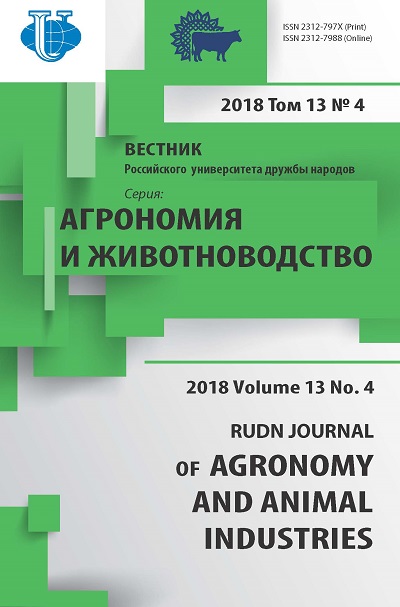RICE LODGING RESISTANCE
- Authors: Avakyan E.R.1, Dzhamirze R.R.1
-
Affiliations:
- Russian Rice Research Institute
- Issue: Vol 13, No 4 (2018)
- Pages: 366-372
- Section: Agronomy and geoponics
- URL: https://agrojournal.rudn.ru/agronomy/article/view/19434
- DOI: https://doi.org/10.22363/2312-797X-2018-13-4-366-372
- ID: 19434
Cite item
Full Text
Abstract
The main direction of breeding grain crops is to increase yield and improve grain quality. For maximum crop yield, it is necessary to develop cultivars with high productivity and quality potential, resistant to biotic and abiotic environmental factors. One of the main characteristics is lodging. Resistance to lodging is determined by well-defined morphological traits: plant height, diameter of the lower internode, panicle length, angle of leaf plate, etc. Short plants are more resistant to lodging than tall ones. Short straw trait can be used when evaluating cultivars for lodging resistance. The ratio of plant height to the diameter of the lower internode is an objectively reliable indicator of rice lodging resistance. The value of this ratio in non-lodging cultivars is less in comparison with lodging ones. The article presents the results of studying morphological traits of different rice cultivars, determining resistance of rice plant to lodging. In the experiment, cultivars differing in height was grouped into three groups (I - tall; II - medium and III - short). Short stem forms were established to be more resistant to lodging. Accents in breeding high-yielding rice cultivars with the lowest risk of yield loss resulting from lodging were identified. The correlation analysis revealed a positive relationship (r = 0.877; 0.945 and 0.500, respectively, in groups) between grain mass per plant and diameter of the lower internode. This indicates a close genetic relationship of the traits studied.
About the authors
Elmira Rubenovna Avakyan
Russian Rice Research Institute
Author for correspondence.
Email: dzhamirze01022010@yandex.ru
Doctor of Biologycal Sciences, professor, leading researcher of Russian Rice Research Institute
Krasnodar, 350921, Russian FederationRuslan Ramazanovich Dzhamirze
Russian Rice Research Institute
Email: dzhamirze01022010@yandex.ru
Candidate of Agricultural Sciences, senior researcher of Breeding department, Russian Rice Research Institute
Krasnodar, 350921, Russian FederationReferences
- Avakyan ER, Aleshin NE, Aleshin EP. Mechanism of gibberellin action on rice. Agricultural biology. 1988; 3:9-19. (In Russ).
- Paleev AM. Biological basis of irrigated agriculture. Moscow: ANUSSR Publishing; 1957. (In Russ).
- Dzhamirze RR, Avakyan ER. New morphotype of rice plant. Typical features. Enthusiasts of agrarian science. 2007; 8:53-27. (In Russ).
- Loskutov IG. Oats (Avena L.) Distribution, taxonomy, Evolution and breeding value. SaintPetersburg: SSC RF VIR Publishing; 2007. (In Russ).
- Petinov NS. The current state of research work on lodging crops and the main promising areas. Minsk; 1965. (In Russ).
- Leninger A. Bases of biochemistry. Moscow: Mir Publishing; 1985. (In Russ).
- Avakyan ER. Physiological and biochemical aspects of rice growth and development. Krasnodar: VNIIR Publ.; 2017. (In Russ).
- Lyakhovkin AG. Physical and mechanical features of rice vegetative organs in connection with plant lodging. VIR Bulletin. 1971; 18:38-43. (In Russ).
- Aleshin EP, Aleshin NE. Rice. Мoscow: Zavodskaya Pravda Publ.; 1993. (In Russ).
- Strutskovskaya ES. Methods for evaluating wheat raw material for lodging resistance. Breeding and seed production. 1968; 2:28-31. (In Russ).
- Kovalev VS, Ostapenko NV. Improving the methods and techniques of laying competitive rice varietal testing. In: Abstracts from the conference of young scientists and specialists. Krasnodar; 1987. p.10-12. (In Russ).
- Smetanin AP, Dzyuba VA, Aprod AI. Methods of experimental work on breeding, seed production and quality control of rice seeds. Krasnodar; 1972. (In Russ).
- Sheudzhen AK, Bondareva TN. Methods of agrochemical research and statistical evaluation of their results: study guide. 2nd ed. revised and enlarged. Maikop: Polygraph-Yug Publishing; 2015.
Supplementary files















